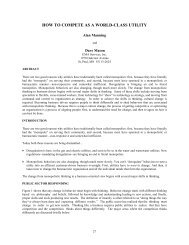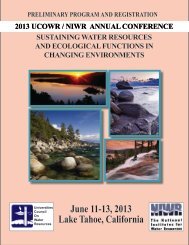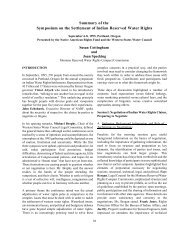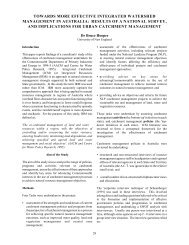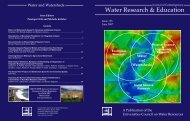30Ashton, Turton, <strong>and</strong> Rouxresource management is centralized <strong>and</strong> the degreeto which management focus is directed towardssupply-side or dem<strong>and</strong>-side options are importantdrivers <strong>of</strong> change within the water sector. Thesedrivers can be represented as axes on a matrix(Figure 1), where the general trend <strong>of</strong> change isshown as a progressive broadening <strong>of</strong> the scope <strong>of</strong>water resource management envelopes from (A)to (C) over time. The upper left-h<strong>and</strong> quadrantrepresents the early phases <strong>of</strong> development, wheremanagement is highly centralized, with a primaryfocus on supply-side options that can provide waterwith a high assurance <strong>of</strong> supply (envelope “A”).Since most emphasis is placed on the construction<strong>and</strong> operation <strong>of</strong> engineering structures to deliverwater (the first order resource), the institutionalneeds reflect this importance <strong>and</strong> the managementcadre consists predominantly <strong>of</strong> engineers <strong>and</strong>hydrologists.As management becomes progressively moredecentralized over time, the changes can berepresented by envelopes “B” <strong>and</strong> “C” in Figure1, with increasing emphasis being placed on theeffectiveness <strong>of</strong> decentralized institutional structures<strong>and</strong> efficiencies <strong>of</strong> water utilization patterns,shown on the horizontal axis. More attention is alsopaid to new policy applications such as inter-sectoralwater allocation <strong>and</strong> efficiency measures such asintra-sectoral allocative incentives, institutionbuilding<strong>and</strong> the efficiency <strong>and</strong> effectiveness <strong>of</strong>operational procedures. This requires a muchs<strong>of</strong>ter approach, seen as a second-order focus,where the principal resource being mobilized issocial capital or social adaptive capacity (Ohlsson1999). Now, effective water resource managementrequires a much wider range <strong>of</strong> skills, <strong>and</strong> includespolicy specialists, social scientists, economists,lawyers, engineers, hydrologists, <strong>and</strong> ecologists, toname but a few specialist disciplines.It is important to note that South Africa’s originalfocus on water supply infrastructure has not beenab<strong>and</strong>oned since this infrastructure still forms thebackbone <strong>of</strong> all water supply measures (Basson etal. 1997). As additional measures are adopted overtime, this is reflected as a widening managementenvelope, whose shape at any given time dependson several external factors. Particularly importantamong these factors are the physical nature <strong>and</strong>availability <strong>of</strong> water resources, <strong>and</strong> the level <strong>of</strong>political “maturity” <strong>of</strong> South African society.Some Views on GovernanceA key part <strong>of</strong> the current global <strong>and</strong> nationaldebates around governance relates to the lack<strong>of</strong> agreement as to what governance comprises(European Union 2001). Even a cursory review<strong>of</strong> the recent literature will reveal that the term‘governance’ has been used to describe a widearray <strong>of</strong> situations or conditions that include theroles <strong>and</strong> responsibilities <strong>of</strong> government, laysociety <strong>and</strong> the business sector, decision-makingprocesses, management actions at all levels,the behavior <strong>of</strong> individuals <strong>and</strong> communities,institutional structures <strong>and</strong> settings, legal <strong>and</strong>statutory instruments, <strong>and</strong> idealized processes <strong>of</strong>participation or collaboration (Ashton in press). Insome cases, the word “governance” simply appearsto have been appended to a particular descriptor <strong>of</strong>a system or situation as if it’s presence in the nowexp<strong>and</strong>edterm could provide greater “legitimacy”or “public acceptability.” This unfortunate featureis one that is also shared by inappropriate use <strong>of</strong>the word “sustainable”—again appended as if itcould confer some form <strong>of</strong> authenticity or validityto a particular situation or activity.Many descriptions <strong>of</strong> governance have also beenlinked to specific considerations, where governanceis considered to be a process, a structure, a system<strong>of</strong> values or a specific outcome. While each <strong>of</strong>these applications are no doubt entirely appropriate<strong>and</strong> legitimate within their specific contexts, thesheer variety <strong>of</strong> these uses has created considerableconfusion about the underlying concept <strong>and</strong>meaning <strong>of</strong> governance <strong>and</strong>, in particular, theconcept <strong>of</strong> “good governance” (Ashton in press).In the context <strong>of</strong> IWRM, it is therefore importantto underst<strong>and</strong> <strong>and</strong> properly contextualize the use <strong>of</strong>the term governance so that it helps to clarify <strong>and</strong>guide decisions <strong>and</strong> actions, rather than adding tothe existing confusion.The South African emphasis on broadening theparticipation <strong>of</strong> stakeholders in IWRM seeks toensure that prudent water resource managementcan enhance the quality <strong>of</strong> life <strong>of</strong> all citizens whilesimultaneously ensuring the long-term viability <strong>of</strong>the water resources upon which all developmentdepends (Department <strong>of</strong> <strong>Water</strong> Affairs <strong>and</strong> Forestry1997). Clearly, this approach mirrors the conceptUCOWRJOURNAL OF CONTEMPORARY WATER RESEARCH & EDUCATION
Government, Society, <strong>and</strong> Science in IWRM In South Africa31<strong>of</strong> sustainable development <strong>and</strong> reflects thefundamental inter-dependence between economicdevelopment, the natural environment, <strong>and</strong>people (World Commission on Environment <strong>and</strong>Development 1987). Importantly, this approachrequires all segments <strong>of</strong> society to co-operate withina governance system that reflects their values,principles, aspirations, imperatives, <strong>and</strong> objectives(Folke et al. 2002). Significantly, this recognitionalso means that government, civil society—or thelay public—<strong>and</strong> scientists or technology providersmust co-operate closely <strong>and</strong> share a common vision<strong>of</strong> the future. This view provides strong supportfor the so-called “Trialogue” model <strong>of</strong> governancethat links government, civil society, <strong>and</strong> sciencein a set <strong>of</strong> partnerships, <strong>and</strong> that promotes closecollaboration <strong>and</strong> interactions between each <strong>of</strong>these sectors (Figure 2). In this view, particularemphasis is placed on the interfaces betweenthe three sectors <strong>and</strong> their contribution to goodgovernance.Here, it is important to recognize that whilethe “government” <strong>and</strong> “science” clusters in theTrialogue represent components <strong>of</strong> the broader“society” cluster, they also represent discretegroupings <strong>of</strong> individuals <strong>and</strong> institutions that mustperform specific actions on behalf <strong>of</strong> society. Inthis conceptual system, the “science” clusterrepresents technology providers that direct theirefforts to improve the quality <strong>of</strong> life in society <strong>and</strong>assist government to deliver on its m<strong>and</strong>ates. Inturn, the “government” cluster represents thoseindividuals <strong>and</strong> institutions that have been selectedby society to provide leadership <strong>and</strong> direction onits behalf. In an ideal situation, the three clustersare inter-dependent <strong>and</strong> mutually supportive <strong>and</strong>their interactions are guided <strong>and</strong> underpinned byagreed sets <strong>of</strong> principles <strong>and</strong> values that combineto deliver good governance as a desirable outcome(Figure 2) (Ashton in press).In practice, the contextual components <strong>of</strong>governance systems are <strong>of</strong>ten misunderstood, orit is assumed that everyone shares a common set<strong>of</strong> values, goals, <strong>and</strong> ideals. This is seldom truein reality, where people living within the samecommunity may differ widely in their abilities,views, <strong>and</strong> aspirations. Similarly, the effectiveness<strong>of</strong> governance systems can be hampered by thePublicGovernment– PublicInterfaceGoodGovernancePublic –ScienceInterfaceGovernmentGovernment–ScienceInterfaceScienceFigure 2. Conceptual diagram illustrating the linkages <strong>and</strong> interfaces between government, science, <strong>and</strong> the lay public,<strong>and</strong> their collective partnerships <strong>and</strong> contributions to “good governance” (modified from Ashton, in press).JOURNAL OF CONTEMPORARY WATER RESEARCH & EDUCATIONUCOWR
- Page 3: Journal of ContemporaryWater Resear
- Page 6 and 7: 2Bruce Hooperinstitutional, and tem
- Page 11 and 12: IWRM: Governance, Best Practice, an
- Page 13 and 14: IWRM: Defi nitions and Conceptual M
- Page 15 and 16: IWRM: Defi nitions and Conceptual M
- Page 17 and 18: IWRM: Defi nitions and Conceptual M
- Page 19: IWRM: Defi nitions and Conceptual M
- Page 22 and 23: 18Cardwell. Cole, Cartwright, and M
- Page 24 and 25: 20Mostert26 water boards responsibl
- Page 26 and 27: 22MostertTable 1. Third National Wa
- Page 28 and 29: 24MostertImplementationThe ambitiou
- Page 30 and 31: 26MostertBiswas, A. K. 2004b. Respo
- Page 32 and 33: 28UNIVERSITIES COUNCIL ON WATER RES
- Page 36 and 37: 32Ashton, Turton, and Rouxassumptio
- Page 38 and 39: 34Ashton, Turton, and RouxEffective
- Page 40 and 41: 36UNIVERSITIES COUNCIL ON WATER RES
- Page 42 and 43: 38Hussey and Doversin water policy
- Page 44 and 45: 40Hussey and Dovers1994 Council of
- Page 46 and 47: 42Hussey and Doversestablished Thes
- Page 48 and 49: 44Hussey and DoversTable 1. Typolog
- Page 50 and 51: 46Hussey and Doversassessment appro
- Page 52 and 53: 48Hussey and Doverspolicy goals.Bey
- Page 54 and 55: 50Hussey and DoversFrawley, K. 1994
- Page 56 and 57: 52Mitchelloften took three to four
- Page 58 and 59: 54Mitchelltree preservation plans;
- Page 60 and 61: 56UNIVERSITIES COUNCIL ON WATER RES
- Page 62 and 63: 58Genskow and Borna series of chall
- Page 64 and 65: 60Genskow and BornTable 1. Watershe
- Page 66 and 67: 62Genskow and Bornthe first Dungene
- Page 68 and 69: 64Genskow and BornWashington, DC.Ko
- Page 70 and 71: 66Green and Fernández-BilbaoWithin
- Page 72 and 73: 68Green and Fernández-Bilbaosubjec
- Page 74 and 75: 70Green and Fernández-Bilbaoinflue
- Page 76 and 77: 72Green and Fernández-BilbaoBerbel
- Page 78 and 79: 74UNIVERSITIES COUNCIL ON WATER RES
- Page 80 and 81: 76BallweberEstablish AdvisoryCommit
- Page 82 and 83: 78Ballweberattributes in others (Ch
- Page 84 and 85:
80UNIVERSITIES COUNCIL ON WATER RES
- Page 86 and 87:
82Barreiraand ground water. To this
- Page 88 and 89:
84Barreirawith other states for int
- Page 90 and 91:
86UNIVERSITIES COUNCIL ON WATER RES
- Page 92 and 93:
88Davis and ThrelfallResource Manag
- Page 94 and 95:
90Davis and ThrelfallTable 2. Thirt
- Page 96 and 97:
92Davis and Threlfallby regional an
- Page 98 and 99:
94Davis and Threlfallenforcement, a
- Page 100 and 101:
96Davis and Threlfallhusbandry prac
- Page 102 and 103:
98Davis and ThrelfallNew Zealand: T
- Page 104 and 105:
100UNIVERSITIES COUNCIL ON WATER RE
- Page 106 and 107:
102Lamoree and van SteenbergenIt is
- Page 108 and 109:
104Lamoree and van Steenbergenand n
- Page 110 and 111:
106Lamoree and van Steenbergeninter
- Page 112 and 113:
108BourgetWorks Planner Capability
- Page 114 and 115:
110Bourgetwith over 600 people resp
- Page 116 and 117:
112Bourgetgovernment’s intrusion
- Page 118 and 119:
114Bourget4.management, drought man
- Page 120 and 121:
116McKayFigure 1. The four paradigm
- Page 122 and 123:
118McKay4. Paradigm 4 (which commen
- Page 124 and 125:
120McKaythree main functions:1. ass
- Page 126 and 127:
122McKayState Implementation of the
- Page 128 and 129:
124McKayTable 2. Corporate governan
- Page 130 and 131:
126McKayFigure 4. Qu. 26 - The ESD
- Page 132 and 133:
128McKayFigure 7. Qu.93- This organ
- Page 134 and 135:
130McKayBrundtland Report. 1987. Ou
- Page 136 and 137:
132UCOWR BOARD OF DIRECTORS/COMMITT
- Page 138 and 139:
134BENEFITS OF UCOWR MEMBERSHIPThe
- Page 140 and 141:
136Past Issues of the Journal of Co
- Page 142 and 143:
138Academic Organizations Membershi
- Page 144 and 145:
140Individual Membership Applicatio
- Page 146 and 147:
Universities Council on Water Resou
- Page 148:
Integrated Water Resources Manageme



